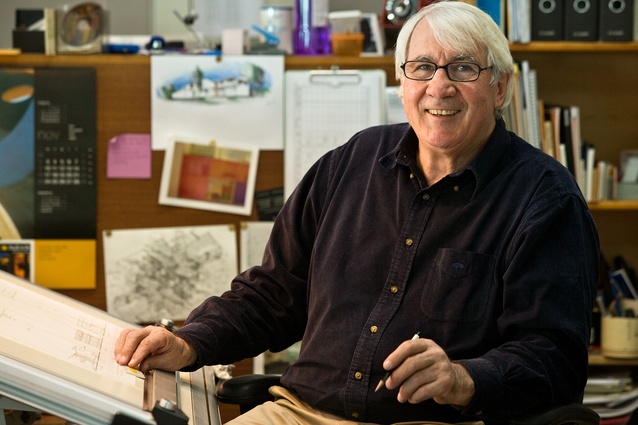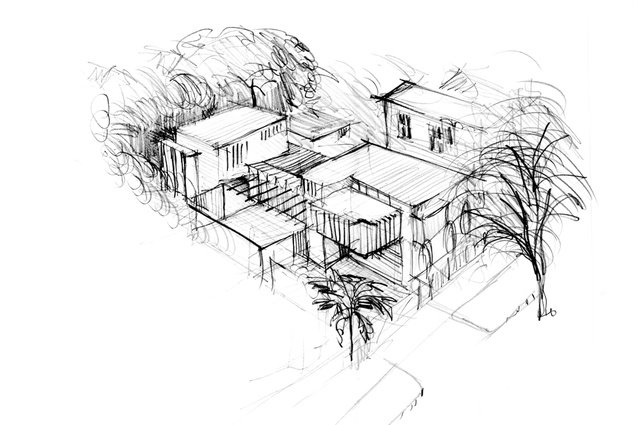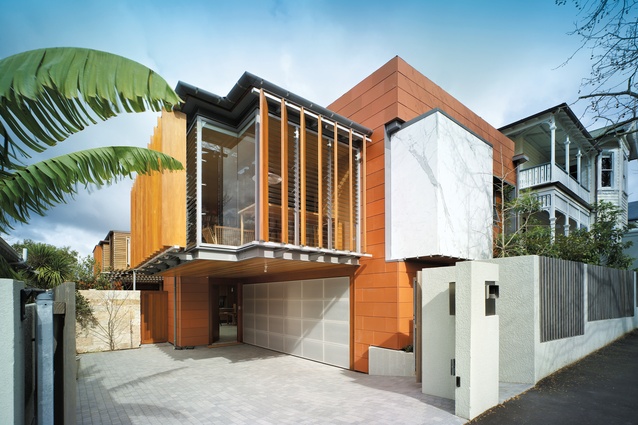Obituary: Marshall Cook
Pip Cheshire and Lindley Naismith pay tribute to NZIA Gold Medal-winning architect and friend Marshall Cook (23 June 1940–28 September 2023).
Words by Pip Cheshire:
Marshall grew up surrounded by the maps and photographs of his cartographer and historical curator father in Napier. School holiday jobs at the local architect’s office introduced him to John Scott and reinforced his enthusiasm for studying architecture. He came to the Auckland School of Architecture in 1959, took time out to work with Bill Wilson and Ivan Juriss — the remnants of Group Architects — John Scott and Lillian Chrystal, then returned to the school to finish in 1966.
Marshall started a practice in 1967 with Terry Hitchcock and they were later joined by Peter Sargisson. In the mid-1970s, he travelled to England and taught timber construction for three years. Upon his return to New Zealand in the late 1970s, the practice undertook a number of ski resort and masterplanning projects in the USA. This was followed by work in Japan and Thailand before withdrawing from international work in the mid-1990s. The practice remained Cook Hitchcock and Sargisson until 1990 and is currently known as Cook Sargisson and Pirie, with a staff of around 15 undertaking predominantly residential projects.
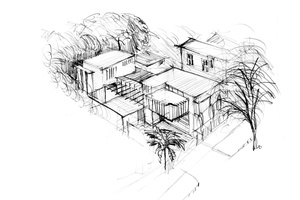
Marshall was always gracious in his support of young, and not so young, architects and of work he admired. His affirmations of a completed project, a piece of writing or a drawing were the result of thoughtful consideration of the work and were delivered with grace, a strong sense of collegiality and, just occasionally, a swipe at another’s not-so-successful project. His messages of support and congratulation were always given without reservation or hint of guarded competitiveness, and were all the more valued for it.
Both Marshall and his practice have been largely known for a series of houses that manage to be both highly civilised and experimental at the same time. In his 40-odd years of practice, he worked restlessly on the evolution of a house type that incorporated a profound understanding of the changing dynamics of families over time, and of the vicissitudes of our climate. The projects, too, invariably incorporated a sensuous pleasure in materials and an adventurous exploration of ways of structuring and building.
Marshall’s empathy for the expansions and conflations of family size over decades, closely experienced in his own family, generated a parti which splits out a secondary living/working area from the main house, invariably linking the two across either an enclosed or partially enclosed courtyard. These secondary living zones allowed for home occupations, the gradual distancing of teenagers from the family bosom, or the return of bits of the family with their own family in tow.
The projects were often inventive in their approach to structure and construction, and sought to minimise the size and quantum of materials employed. The Pier Z project at Westhaven, for example, uses yacht technology’s millennium rig buried within façade fins to stiffen the large north-facing glazed façade, while a combination of mezzanine floor diaphragm and service enclosure buttresses against lateral load.
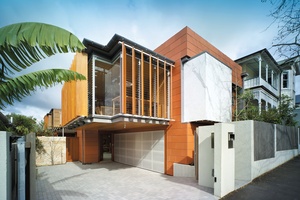
The thinking underpinning this approach was mirrored in Marshall’s constant seeking out of new projects, materials and processes. Though his work was always marked by a gentle civility and concern for fit, be it built context, climate or social organisation, each was always another step in the evolution of his thinking. The two Cook family houses, at Parnell and Freemans Bay, show a clear lineage and development of his strategies for the accommodation of families, an increasingly sophisticated manipulation of environmental controls and an enriching of the material palette employed. Where the Parnell house borrows a European-like parti of villa and courtyard, the Freemans Bay house joins two enclosures with a light pavilion. Where the former has a solid block with deeply penetrating openings, the latter’s two blocks are overlaid by assemblies of fins and a profusion of materials that I suspect might be given short shrift in Parnell.
Marshall’s ability to achieve consent for a house with such an eclectic façade as that in Franklin Road is testimony to his ability to prevail over bureaucratic nonsense, using all possible means at his disposal, ranging from well-reasoned argument to goodhumoured bombast. These are skills that Marshall also put to good use as both urban commentator and teacher. In both roles, he brought a strong, pragmatic understanding of human behaviour, a healthy regard for the complexities and opportunities of construction and design, and a relentless desire to civilise the city. His observations were born of extensive travel and offshore work, the latter involving the masterplanning of ski villages in the US and the design of urban transit stations in Asia.
Marshall was an enthusiastic supporter of architectural activity in all its guises: institute, association, competitions, exhibitions, publications, conferences and that vital glue of architectural discourse, the open bottle of wine. In all roles, Marshall’s mercurial and all-encompassing sociability made him a pivot around which much of Auckland’s architecture and architectural community rotated.
Words by Lindley Naismith:
In the early 1980s, two young female architectural graduates found themselves working at Cook Hitchcock and Sargisson from the practice’s villa office in St Georges Bay Road in Parnell. They were Julie Stout and me. We were its first female architectural employees. We had met Marshall in the final years of our BArchs when he started teaching at the University of Auckland School of Architecture, after his return from an OE with his family to Europe and the UK, where he had also found work teaching architecture. We got to know him better over regular post-studio drinks at the Kiwi Tavern, where students and teachers, several of whom were practising architects as he was, fraternised. In what was a quirk of history of its time, a rare bond was forged between two generations of two groups of friends — fledgling architects and emerging architects — whose developing professional lives became uniquely intertwined. Like gravity (or perhaps dark matter?), Marshall was a fundamental connecting force.

Marshall lived and breathed what te ao Māori has given us an elegant word for: whanaungatanga – ‘relationship, kinship, sense of family connection – a relationship through shared experiences and working together which provides people with a sense of belonging’. Whichever of his worlds you inhabited, entering Marshall’s orbit meant you would be embraced, enfolded and included.
Marshall loved people, he loved life, he loved beauty. He celebrated these loves through his architecture, which he deeply believed had the power to transform. He loved those who shared a love of the things he loved — not only architecture but his family, anyone’s babies, animals, students, good builders, trees, sailing, old cities, new cities, discourse, rugby, curry, wine, books, whisky. He took every opportunity to enjoy his loves, preferably in elaborate combination.
This was the ‘Marshall-verse’. Anyone who succumbed to its gravitational pull has an array of stories about their experiences. Many are friends, or better friends, because of their encounters there. Julie conveys something of it in her tribute: “What sadness to realise that honey warm voice will never more proclaim — his greetings, his thoughts, his declamations. I’m writing this from a rooftop bar overlooking the Bosporous, a place he knew and loved. It was Marshall who knew that Kahurangi, a wonderful Auckland yacht, was now in Turkey, just waiting for adventures. Marshall always knew these sorts of things. Infuriatingly so, at times.

Marshall was the most generous person I knew — especially with his time and his knowledge. He transformed the lives of many of us young students by including us in the camaraderie of the architectural community. With Prue, he loved connecting threads and people. He knew how to make a place a home, how to shape a space and why. Auckland, and we, are so much better for him having been in our lives.”
In late July, we celebrated the formidable legacy of Cook Hitchcock and Sargisson at a gathering of as many as we could round up of five decades’ worth of founders, employees, collaborators, close contacts, and Friday lunch and Friday night drinks regulars. Although the assembled represented just a portion of the Marshall-verse, many of us characterised the successive generations of young architects who were “transformed”, as Julie describes.
Marshall’s extraordinary investment in the architectural journeys of so many through his unselfconscious desire to instil the pleasure and richness that he himself found in the arts of his profession, unsurprisingly, also extended to a lifetime commitment as a teacher of students of architecture in the academy. Teaching and mentoring were fundamental to his own sense of his life’s work, as important to him as was his architectural practice. His architectural DNA is apparent in the buildings and demeanour of so many colleagues who found not only an architectural expression but a path in the profession, thanks to his influence – myself included.
Marshall did everything in his power to have the life he wanted, and what a splendid life it was.


